A region of Bacillus subtilis CodY protein required for interaction with DNA
- PMID: 15937175
- PMCID: PMC1151725
- DOI: 10.1128/JB.187.12.4127-4139.2005
A region of Bacillus subtilis CodY protein required for interaction with DNA
Abstract
Bacillus subtilis CodY protein is the best-studied member of a novel family of global transcriptional regulators found ubiquitously in low-G+C gram-positive bacteria. As for many DNA-binding proteins, CodY appears to have a helix-turn-helix (HTH) motif thought to be critical for interaction with DNA. This putative HTH motif was found to be highly conserved in the CodY homologs. Site-directed mutagenesis was used to identify amino acids within this motif that are important for DNA recognition and binding. The effects of each mutation on DNA binding in vitro and on the regulation of transcription in vivo from two target promoters were tested. Each of the mutations had similar effects on binding to the two promoters in vitro, but some mutations had differential effects in vivo.
Figures








Similar articles
-
Purification and in vitro activities of the Bacillus subtilis TnrA transcription factor.J Mol Biol. 2000 Jun 30;300(1):29-40. doi: 10.1006/jmbi.2000.3846. J Mol Biol. 2000. PMID: 10864496
-
Activation of the Bacillus subtilis global regulator CodY by direct interaction with branched-chain amino acids.Mol Microbiol. 2004 Jul;53(2):599-611. doi: 10.1111/j.1365-2958.2004.04135.x. Mol Microbiol. 2004. PMID: 15228537
-
Genetic and biochemical analysis of CodY-binding sites in Bacillus subtilis.J Bacteriol. 2008 Feb;190(4):1224-36. doi: 10.1128/JB.01780-07. Epub 2007 Dec 14. J Bacteriol. 2008. PMID: 18083814 Free PMC article.
-
CodY, a master integrator of metabolism and virulence in Gram-positive bacteria.Curr Genet. 2017 Jun;63(3):417-425. doi: 10.1007/s00294-016-0656-5. Epub 2016 Oct 15. Curr Genet. 2017. PMID: 27744611 Review.
-
Control of key metabolic intersections in Bacillus subtilis.Nat Rev Microbiol. 2007 Dec;5(12):917-27. doi: 10.1038/nrmicro1772. Nat Rev Microbiol. 2007. PMID: 17982469 Review.
Cited by
-
Identification of CodY targets in Bacillus anthracis by genome-wide in vitro binding analysis.J Bacteriol. 2013 Mar;195(6):1204-13. doi: 10.1128/JB.02041-12. Epub 2013 Jan 4. J Bacteriol. 2013. PMID: 23292769 Free PMC article.
-
Role of serine/threonine protein phosphatase PrpN in the life cycle of Bacillus anthracis.PLoS Pathog. 2022 Aug 1;18(8):e1010729. doi: 10.1371/journal.ppat.1010729. eCollection 2022 Aug. PLoS Pathog. 2022. PMID: 35913993 Free PMC article.
-
Integration of metabolism and virulence by Clostridium difficile CodY.J Bacteriol. 2010 Oct;192(20):5350-62. doi: 10.1128/JB.00341-10. Epub 2010 Aug 13. J Bacteriol. 2010. PMID: 20709897 Free PMC article.
-
In Vitro Selection Identifies Staphylococcus aureus Genes Influencing Biofilm Formation.Infect Immun. 2023 Mar 15;91(3):e0053822. doi: 10.1128/iai.00538-22. Epub 2023 Feb 27. Infect Immun. 2023. PMID: 36847490 Free PMC article.
-
Interaction of Bacillus subtilis CodY with GTP.J Bacteriol. 2008 Feb;190(3):798-806. doi: 10.1128/JB.01115-07. Epub 2007 Nov 9. J Bacteriol. 2008. PMID: 17993518 Free PMC article.
References
-
- Blagova, E. V., V. M. Levdikov, K. Tachikawa, A. L. Sonenshein, and A. J. Wilkinson. 2003. Crystallization of the GTP-dependent transcriptional regulator CodY from Bacillus subtilis. Acta Crystallogr. Sect. D 59:155-157. - PubMed
-
- Brennan, R. G., and B. W. Matthews. 1989. The helix-turn-helix DNA binding motif. J. Biol. Chem. 264:1903-1906. - PubMed
Publication types
MeSH terms
Substances
Grants and funding
LinkOut - more resources
Full Text Sources
Other Literature Sources
Research Materials

